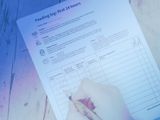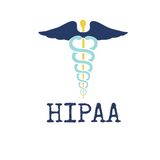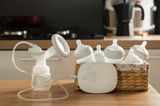While creating my Basics of Breastfeeding and Chestfeeding class, I knew I wanted to give new parents not just lactation knowledge, but also help with the day to day of newborn care. Especially now, while help is harder to come by.
All the families I work with tend to share some basic questions around feeding and look for reassurance that their baby is getting enough to eat. So I collected all my normal answers and advice into a reference that gives some simple guidance for the weeks after birth. I am always working under the assumption that the time right after your baby is born is not your best remembering time! If you're a new parent, you're probably doing your best to figure out all the things you need to know while tired and with hormones rushing around your body. (And a hormonal response to parenthood is universal, whether you carried your baby in your body or not.) A quick reference like this can really help you track the details and coordinate with partners or other caregivers, and hopefully relieve some stress.
One of my goals is to reduce stress for families in the early postpartum period, so I'm making this resource more widely available. If you're in new baby land, sign up for my newsletter and you can download it for free. You can read a little more about how to use the chart below, or skip straight to the signup and download it.
Want to share this file? I'd love you to! Please direct friends or clients here to my website if you think they'd find this resource useful. I'm working on providing lots of resources free to families, and you'll be helping me grow my newsletter and business. Here's a shareable link. Thank you! ❤️
Remember, if your baby is not feeding, peeing, or pooping frequently enough, or meeting weight-gain goals, it’s important to check in with your lactation consultant, midwife, nurse, doctor, or other healthcare provider. It may be another variation of normal, or it may be that your baby isn’t getting enough milk.
Here's what you'll find in this baby feeding log
- Reminders of what you should expect in the first days of life, as things change quickly day by day.
- Charts of how many diapers per day to expect.
- Space to record when your baby is eating at the breast/chest or being supplemented.
- Space to record when your baby pees or poops, as this can be an indicator that your baby is getting enough to eat.
- An extra table for when you pump. If you are pumping in the early days, it can be good to record how much you are producing, so that you can get a picture of what is happening. My experience from working with families is that having pumping and all the other info about baby on the same log is generally pretty confusing. Record human milk and/or formula feedings in the feeding chart and pumping in the pumping chart to stay clear on how often baby is being fed.
The information you log can be useful for your lactation consultant or other healthcare provider to help assess how your baby is doing.

When it makes sense to log
- Newborn feeding charts are great for parents who are doing some or all of their infant feeding at the breast or chest. Most new parents need lots of support and easy reminders of what to expect as they begin to learn how to feed their baby.
- Logs are great for parents who are struggling with milk supply to keep a close eye on what is going on with their baby and their body. If you start a new nutritional supplement or medication, are you seeing results? How often did your baby really end up feeding each day? Hours and days can blur together sometimes. Accurately logged information can help you and your care provider make adjustments to help you meet your goals.
- Parents who take turns with baby care or have other caregivers in the mix often find logging helps everyone stay on the same page. They may end up logging longer term, as it's an easy way to communicate between caregivers.
How to use these logs
- At the beginning of the day, take a look at the top of the page and remind yourself of what you can expect in this 24 hours. There are notes and reminders on what to expect regarding weight, feeding, temperament, and eliminations.
- You can record your baby's weight on the days that you see a provider (pediatrician or lactation consultant) who weighs them.
- Throughout the day, record when your baby pees or poops and put a check mark in the box. The plus (+) checkbox just indicates any extra eliminations—if your baby pees or poops more frequently than the expected amount that is ok too. For example, in the first 24 hours, babies are only expected to pee once. More than one pee isn’t a problem, but the chart helps you watch for that one pee diaper.
- Then fill out the table throughout the day as you feed your baby. Remember to take note of the time when the feeding began as you likely be recording information at the end of each feeding. If you need additional rows for notes you can print extra blank tables (at the end of the PDF).
- If you are pumping, record the information on the pumping table provided, so that you can easily track pumped amounts separately.
- At the end of the day you can easily see if your baby is feeding and eliminating as frequently as is expected, which can often be a sign of whether or not your baby is getting enough to eat.
- Repeat tomorrow!
If each day all the boxes are mostly following the pattern of expected feeding, eliminations, and temperament, that is a great sign that your baby is getting all they need to eat!
If you have multiples, it's easy to fill out one sheet per baby—as you will need even more help keeping track to make sure each baby is getting enough to eat!
When not to log
Think of logs as still being a form of intervention. Just like any intervention they should be used when they are helpful and discontinued when they no longer serve a purpose. My hesitation to recommend logs is that some parents can be harmed rather than helped by the focus on the details.
Questions to ask yourself:
- Is it well established that my baby is eating regularly and gaining well?
- Am I feeding on demand, based on my baby's behavior?
- Are the logs making me anxious?
- Am I overly focused on the details of the log?
- If I don’t pump quite as much one time, does that make me worried?
If you answer yes to any of these questions, then its likely time for you to move on from logging, and to follow their cues as to when they need to eat and sleep. A healthy baby will communicate their needs to you!
Download the printable feeding log
Thanks for reading! You can click here to sign up and download this resource. If you find it useful, I'd love to hear! You can look me up on social media or join the Woven Facebook group for families.




